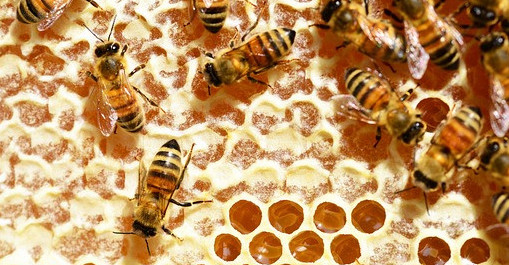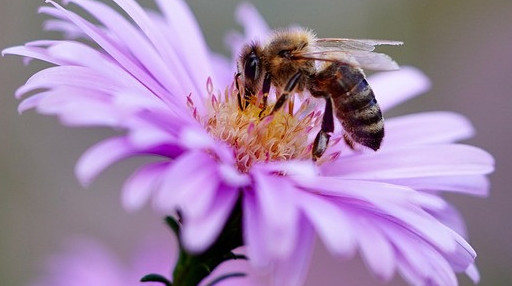HONEY IN HISTORY
The collection of honey has an ancient history and story. A painting in Spain that dates back over 8,000 years shows two people climbing a tree to collect honey from a wild bee’s nest. Even more amazing is honey’s ability to remain a food for thousands of years! Edible honey has been found in clay jars in Georgia that are over 5,000 years old. Honey has been used for centuries as a sweetener, in cosmetics and to mummify the dead. Athenians practiced beekeeping and in 594 BC it was so common that laws governed how hives could be kept. One law stated, “He who sets up hives of bees must put them 90 meters away from those already installed by another.” Ayurveda texts of ancient India record honey being used in both spiritual and therapeutic ways. There are Biblical references to the use of honey also. Israel is referred to as “the land of milk and honey.” In several instances honey is referred to as a symbol of spiritual perfection. Honey is a common food referred to by many religions across the globe. Honey was apparently produced commercially in an apiary that dates from the 10th century BC in Tel Rehov where over half a ton of honey was made by bees from over 100 hives.

HONEY AS FOOD
Even though honey has been used for thousands of years as a mummifier, a preservative and in many therapies the way most of us think of honey is as a sweetener and for food purposes. Since the tremendous increase in the interest in healthy foods honey has become more popular than ever as a sweetener and flavor enhancer. Traditionally honey has been used for cooking, baking, in sweet desserts, as a spread for breads, and to enhance teas and other beverages. Today, in North America especially, honey is being added to all kinds of foods to give them an appearance of being good and healthy. Often the actual honey being added to these foods is negligible. To use the term “honey” has, in many cases, become an advertising ploy.
Honey comes in many different colors and flavors depending upon the flowers and areas of the world it comes from. For example many common honeys in North America are wildflower, clover, orange blossom, sage, tupelo, buckwheat, fireweed, mesquite, sourwood, cherry and blueberry. The honeys of Australia tend to be unique to that region because of the local flora. Several popular ones would be macadamia, ironbark, Tasmanian leatherwood and ironbark. A few examples from Europe would be thistle, heather, thyme, sunflower, and lavender. Different flavors of honey can give a totally different flavor to baked goods and prepared foods. Often honeys are blended to make them more commercially available. One example of this could be the very popular wildflower honey which may be derived from the nectar and flowers of different regions. Wildflower honey may also vary in flavor from year to year.
Mead, wine made from honey, may well be the oldest fermented beverage. Popular in many countries, it is prepared in a variety of ways which are totally dependent upon the individual society and culture. Some prefer spices such as cinnamon, some are made with grape juices, others are made with a certain honey flavor. Beer is also made with honey and I have observed the last few years more and more breweries producing a honey flavored beer. Personally, I truly enjoy a glass of well-chilled mead produced from a nice wildflower honey.
HONEY CLASSIFICATIONS
Honey can be marketed in a variety of ways. Normally it is sold as a liquid but can be processed in several forms. Among those are the following:
CANDIED OR CRYSTALLIZED HONEY is available when part of the glucose content has crystallized. It can be returned to the liquid state simply by gently warming the crystallized honey.
RAW HONEY is basically as it came from the hive. It is strained and may contain some pollen and/or particles of wax. It may be “minimally procesed” and still labeled as raw.
PASTEURIZED HONEY has been heated to at least 161 degrees F. and may have lost some enzyme activity. It may also be darker in color and have a change in taste.
FILTERED HONEY is honey that has been heated and passed through a filtration system. The system used most often is to add diatomaceous earth to honey at 140 degrees F. and pass it through a filter paper.
ULTRASONICATED HONEY has been sonicated and loses some of its yeast cells. This is done at a low temperature.
CREAMED HONEY is a whipped style honey that is smooth and spreadable.
COMB HONEY is available still in the comb of the honeybee. Some honey purists prefer this style honey.
BAKER’S HONEY is honey that falls outside the regular honey specifications. It may not be sold on the open market labeled simply as “honey.” It is used in food processing.

THE 21ST CENTURY IMPORTANCE OF BEES
Bees have gained a new importance in the 21st century. Honey as food and flavoring has been the most important function of bees for centuries. They still have that role to play but have gained an even more important role today in the production of food. Bees are extremely important as pollinators. There are many pollinators in nature, such as birds, moths, butterflies, wasps and others. The Western honey bee is very important to the support of healthy ecosystems needed for clean healthy air, wildlife health and stable soils. There are more than 100 commercial crops grown in the US that are dependent upon pollinators. It is estimated by the USDA that pollinators add $18 Billion to crop revenue income. The value of honey and related products alone exceeds $700 million. Colony Collapse Disorder (CCD) was noted in 2006 by experts in the field. This CCD is being caused by a number of factors, including diseases, pesticides, pollutants, toxins, habitat loss, climate changes and the intensification of agricultural practices. Through the efforts of the USDA and beekeeper organizations the rate of colony collapse has decreased the last few years but still must be controlled. Individuals can contribute to this effort by planting flower gardens and maintaining their yards and gardens using fewer herbicides and pesticides.
I MAY EARN A COMMISSION FROM ITEMS PURCHASED ON THIS SITE.
PLEASE LEAVE ANY QUESTIONS OR COMMENTS.
After reading this blog post, I appreciate your perspective on the health benefits of honey. The post does a good job of outlining the various nutrients and antioxidants found in honey, as well as its potential to help with issues such as sore throats and digestive problems.
However, I would also like to offer a balanced opinion on the topic. I hope you don’t mind.
While honey certainly has some health benefits, it’s important to remember that it is still a form of sugar and should be consumed in moderation. Overconsumption of honey can lead to an increase in blood sugar levels and contribute to health issues such as obesity and type 2 diabetes.
Additionally, it’s important to note that not all honey is created equal. Many store-bought brands of honey have been processed and may not contain the same levels of nutrients and antioxidants as raw, unprocessed honey.
Good comments, Dave. No, all honeys are not created equal! In fact, some honey can actually be toxic in very rare cases. Yes, honey is sugar and should be sued accordingly!
Hey! I read your post about the history and different classifications of honey. It was interesting to learn about how honey has been used throughout history, from ancient civilizations using it as a sweetener to modern-day industries incorporating it into their products. I also found it helpful to know about the different types of honey available on the market and their varying flavors and uses. It’s impressive how bees have such an essential role in producing honey, pollinating crops, and supporting ecosystems. Overall, great post!
Thanks for your comments!
It was really interesting to read that honey has been used for so long, even going as far back as being used as a preserver of food. I see honey is also used in many beauty products. Being made in nature, how can it not be good for you? I am sure it is way better than the refined sugar we eat in our food nowadays.
It is so sad that our bees worldwide are becoming endangered. I think I read somewhere that a world without bees will also be a world without humans. So let’s all do all we can to look after our bee friends so that we can enjoy the earth for many more decades to come.
Agreed, Michel!